Dinner holds a unique place in our daily lives. It’s more than a routine meal—it’s an opportunity to end the day with nourishment, reflection, and intention. For those striving to live a healthier lifestyle, understanding what makes a healthy dinner can be a game-changer. It’s not simply about calories or avoiding late-night eating; it’s about choosing the right ingredients that offer deep, sustaining nutrition, contribute to metabolic health, and support better sleep and digestion.
So what does science actually say about the ideal food for dinner? How do we build meals that are satisfying, nutrient-rich, and easy to prepare on even the busiest of nights? And why do some meals leave us feeling sluggish, while others energize and stabilize us well into the next day? In this in-depth article, we’ll explore how to create healthy filling dinners that support your well-being, focusing on dinner items with easy nutrients that fit naturally into your routine. Grounded in the principles of evidence-based nutrition, this guide is your expert-backed roadmap to building better evening meals.
You may also like: Smart, Simple Recipes for a Balanced Diet: Expert-Backed Healthy Food Dishes to Support Everyday Wellness
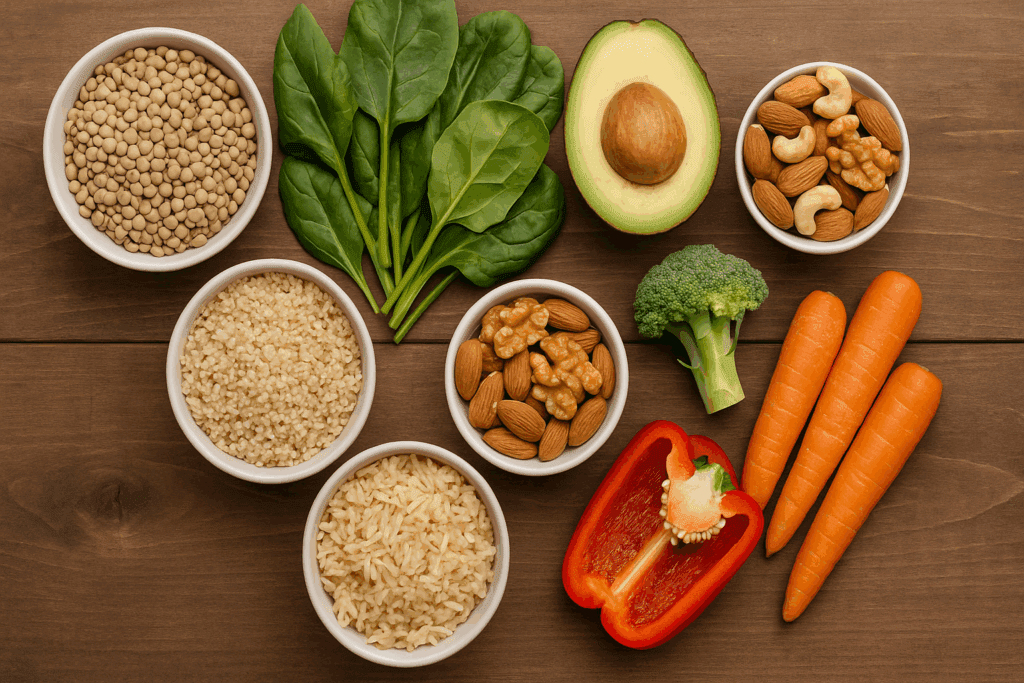
What Defines a Healthy Dinner? A Foundation of Balance and Purpose
At its core, a healthy dinner is a balanced blend of macronutrients and micronutrients designed to restore your body’s energy, repair tissues, and prepare you for restful sleep. Unlike crash diets or trendy cleanses that promise quick results, a truly nourishing dinner embraces sustainability, variety, and long-term support for your physiological and emotional needs. The keyword isn’t restriction—it’s balance.
Most nutrition experts agree that the ideal dinner should include high-quality protein, complex carbohydrates, healthy fats, and ample fiber. Protein plays a key role in muscle repair and appetite regulation, and should ideally come from clean, minimally processed sources like lentils, beans, tofu, or tempeh. When combined with whole grains and fiber-rich vegetables, these proteins form the bedrock of what makes a healthy dinner.
Complex carbohydrates from sources like quinoa, brown rice, or sweet potatoes are equally essential. Unlike refined grains, these carbs release glucose slowly into the bloodstream, providing long-lasting energy without the spikes and crashes associated with simple sugars. And healthy fats—think avocado, flaxseed, or olive oil—not only enhance flavor and satiety but also aid in nutrient absorption and brain function. Together, these elements create a harmonious meal that supports everything from immune strength to mood stability.
What sets these meals apart is their nutrient density—foods that are rich in vitamins, minerals, and antioxidants without being high in calories or processed additives. This is what nutritionists refer to as dinner items with easy nutrients—foods that provide maximum benefit with minimal effort or complication.

The Power of Nutrient-Dense Simplicity
In the real world, dinner doesn’t need to be fancy to be nourishing. Some of the most effective meals are built from just a few whole-food ingredients that offer synergistic health benefits. The trick lies in understanding how to pair foods that maximize absorption, keep you full, and support your body’s natural cycles.
Take, for example, a bowl of lentils with roasted vegetables and a drizzle of tahini. This simple meal provides plant-based protein, complex carbs, healthy fat, and a wide spectrum of micronutrients like folate, magnesium, and iron. It’s also packed with fiber, which plays a key role in gut health, cholesterol management, and hormonal balance. This type of meal exemplifies healthy filling dinners—dishes that satisfy without overloading your digestive system.
These meals often rely on “easy” nutrients—ingredients that cook quickly, store well, and retain their nutritional value. Leafy greens like spinach or kale, cruciferous vegetables like broccoli or cauliflower, and legumes like chickpeas are all excellent options. They’re not only fast to prepare but also powerhouses of essential vitamins and minerals. By rotating through these types of ingredients, it becomes easy to maintain variety while still delivering the building blocks of wellness at each meal.
Incorporating these simple, nutrient-dense foods into your evening routine offers more than just physical nourishment. It builds a sense of ease and confidence in the kitchen—key factors in sustaining long-term dietary changes. After all, meals that are too complex or time-consuming are far less likely to become part of your regular habits.
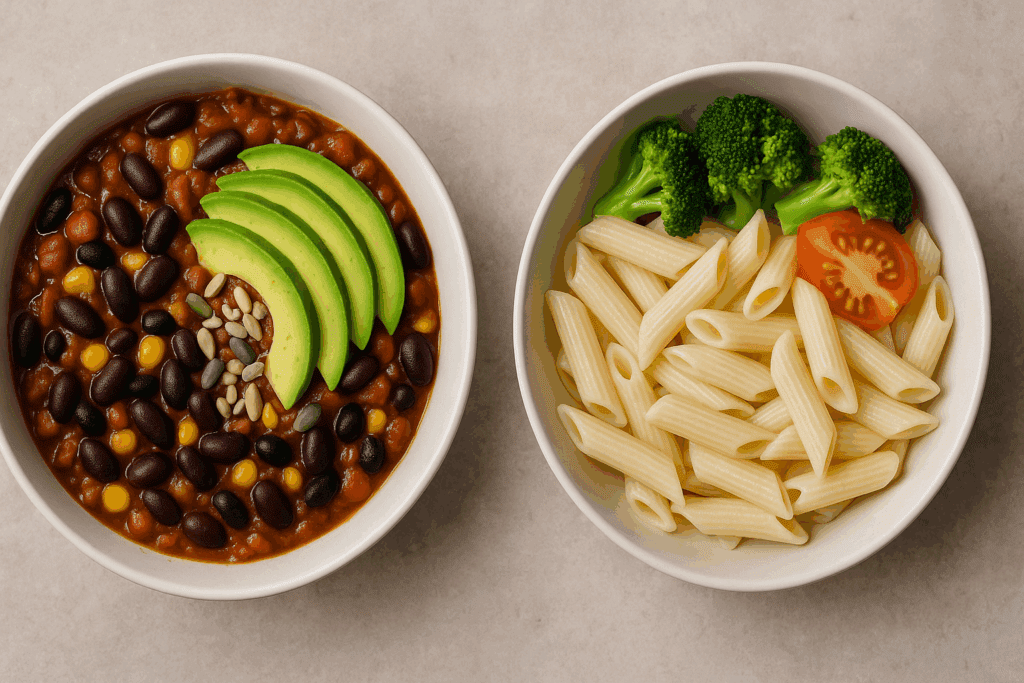
Satiety Without Excess: How to Stay Full and Nourished
The concept of satiety—feeling full and satisfied after a meal—is central to understanding what makes a healthy dinner. It’s not just about how much you eat, but what you eat and how it interacts with your body’s hunger-regulating hormones. Foods high in fiber and protein tend to be the most satiating, especially when paired with healthy fats that slow digestion and improve nutrient uptake.
This is why meals that are rich in legumes, whole grains, and hearty vegetables tend to perform well as healthy filling dinners. A bowl of black bean chili, for instance, not only provides slow-digesting carbs and plant-based protein but also offers a dense fiber matrix that keeps you feeling full for hours. Add a topping of avocado or a sprinkle of pumpkin seeds, and you’ve added healthy fats and key minerals like zinc and magnesium to support everything from immune function to relaxation before bed.
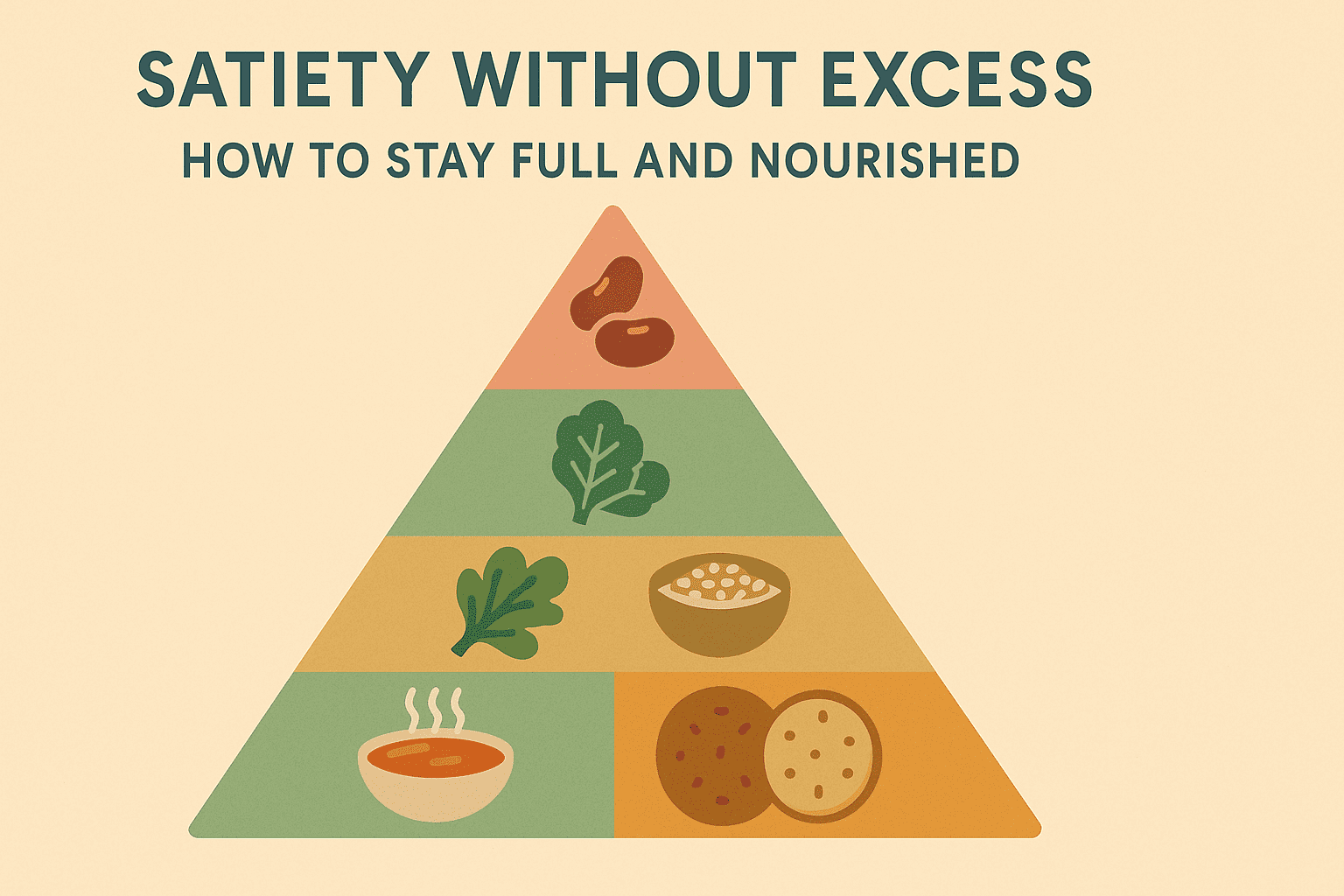
In contrast, meals high in refined carbohydrates or low in protein often leave you reaching for snacks later in the evening. These foods may offer quick energy, but they lack staying power. That’s why understanding the impact of nutrient composition on satiety is so important when choosing the ideal food for dinner.
Moreover, the texture, temperature, and flavor profile of your meal also influence satiety. Meals that are warm, aromatic, and rich in umami tend to feel more satisfying, even when calorie content is moderate. By including a diversity of textures—crunchy, creamy, chewy—you engage more senses, which can help signal the brain that a complete and satisfying meal has been consumed.
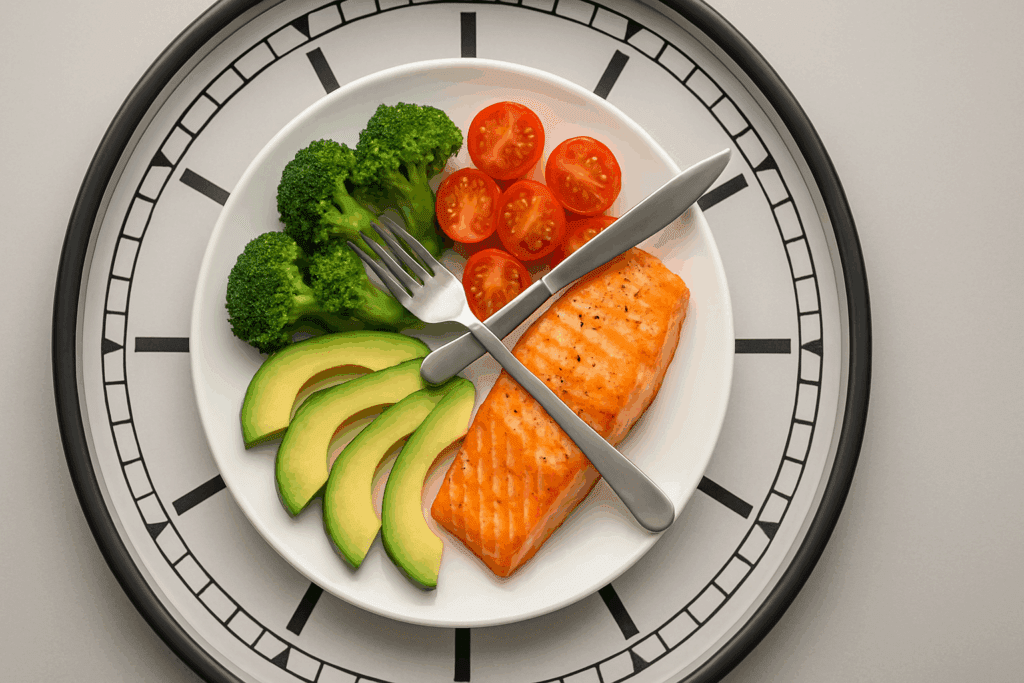
Timing and the Circadian Clock: When You Eat Matters
While we often focus on what we eat, when we eat can also play a significant role in determining how healthy our dinners are. Circadian rhythms, the natural biological processes that follow a 24-hour cycle, influence everything from hormone production to digestion. Eating late at night, especially heavy or high-fat meals, can disrupt these rhythms and negatively affect sleep quality, metabolic health, and insulin sensitivity.
The body’s ability to process food is more efficient during the earlier part of the day, making a strong case for eating dinner at least two to three hours before bedtime. This allows for optimal digestion and reduces the likelihood of acid reflux or blood sugar spikes during the night. A well-timed meal composed of balanced macronutrients can help promote restorative sleep and prevent the fatigue that often follows poor nighttime eating habits.
This doesn’t mean you need to eat dinner at 5 p.m., but it does highlight the importance of consistency and moderation. Meals that are too large or heavy in fat late at night can impair sleep and digestion, while light but nutrient-dense meals support the body’s natural wind-down process. Choosing dinner items with easy nutrients that are simple to digest—like steamed vegetables, lentils, or a modest portion of whole grains—can help you align your evening routine with your body’s biological needs.
Additionally, incorporating foods that naturally promote relaxation, such as magnesium-rich leafy greens, tryptophan-containing legumes, or herbal teas like chamomile or lemon balm, can help prepare the nervous system for rest. These choices underscore the connection between nutrition and sleep quality—a key, often-overlooked aspect of what makes a healthy dinner truly effective.
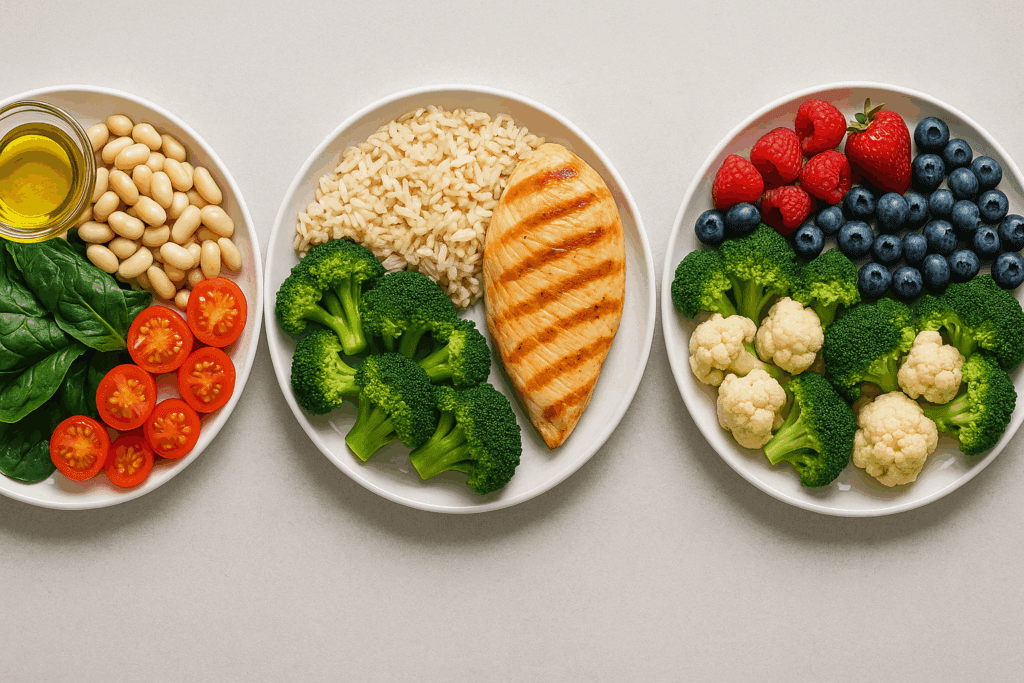
Customizing Dinner for Personal Health Goals
No two bodies are alike, and understanding how to personalize your evening meals is essential for making sustainable changes. Someone focused on managing blood sugar levels might prioritize low-glycemic carbohydrates and higher protein, while another person looking to reduce inflammation may lean toward antioxidant-rich vegetables and omega-3 fatty acids. The beauty of a mindful approach to dinner is that it can be customized based on your unique biology and goals.
For example, a heart-healthy dinner might include fiber-rich grains, cruciferous vegetables, legumes, and olive oil. These ingredients help reduce LDL cholesterol and support vascular integrity. Meanwhile, someone recovering from intense workouts might benefit from a dinner high in protein and complex carbs to replenish glycogen stores and repair muscle tissue.
This is where healthy filling dinners truly shine—they can be adapted and scaled to meet almost any dietary need, from weight management to autoimmune support to digestive health. The unifying principle is nutrient density: every bite should contribute to your wellness, whether through micronutrients, plant compounds, or healthy fats.
It’s also important to account for food preferences, cooking skills, and cultural traditions. A healthy dinner doesn’t have to be salad-based or grain-heavy; it can be a vibrant stew, a lentil dosa, or a quinoa-stuffed bell pepper. When meals are enjoyable and culturally relevant, they’re far more likely to stick. The point isn’t to follow rigid dietary rules, but to cultivate awareness and flexibility around your choices—key aspects of any lasting wellness strategy.
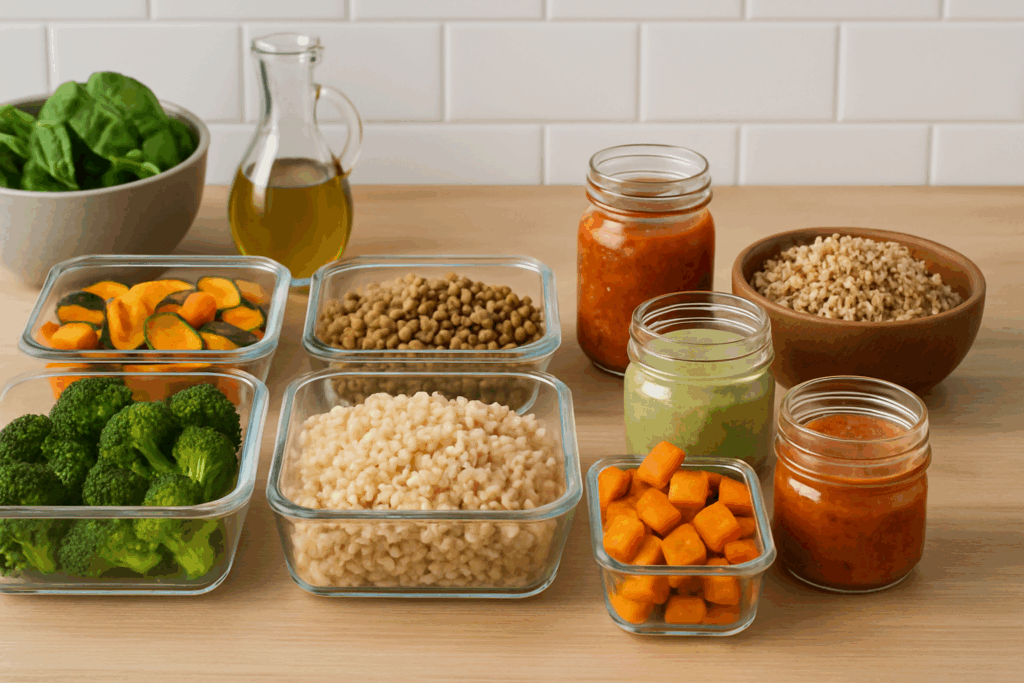
Making it Practical: Building Healthy Dinners into Everyday Life
Understanding nutrition is one thing—putting it into practice is another. Life is busy, and even the most health-conscious individuals face obstacles like time constraints, fatigue, or limited access to fresh ingredients. That’s why building a framework around dinner items with easy nutrients is so important. These are the meals you can throw together quickly, with minimal cleanup and maximum nutritional value.
Batch cooking is a powerful strategy. Preparing staples like brown rice, roasted vegetables, or lentil soup in advance means you always have components on hand for quick assembly. Freezing extras or making use of high-quality canned or frozen vegetables can streamline the process even further.
It’s also useful to keep a few universal flavor builders in your pantry or fridge—like tahini, tamari, nutritional yeast, miso paste, or lemon juice. These ingredients can transform even the simplest dishes into something complex and satisfying. Learning a few basic cooking techniques, such as how to sauté aromatics or how to roast vegetables to bring out their natural sweetness, can help even novice cooks feel confident in the kitchen.
Ultimately, dinner doesn’t need to be an elaborate production. What matters most is consistency and intention. When you focus on simple, whole ingredients and structure your meals around what makes a healthy dinner, you lay the groundwork for sustainable wellness—without the overwhelm.
Frequently Asked Questions (FAQ): What Makes a Healthy Dinner? Expert-Approved Insights on Dinner Items, Nutrient Density, and Lasting Fullness
1. Can healthy dinners actually improve sleep quality and nighttime recovery?
Yes, the quality of your dinner has a significant impact on how well you sleep and how your body recovers overnight. Meals that include magnesium-rich foods—such as leafy greens, legumes, and seeds—can promote deeper sleep due to their role in muscle relaxation and nervous system regulation. When you choose dinner items with easy nutrients that digest efficiently, your body can focus more on overnight repair instead of processing a heavy, late meal. The ideal food for dinner, in this case, emphasizes simplicity, hydration, and nutritional balance. If your goal is restorative sleep, avoid excessive saturated fat and refined sugar in the evening, as they can disrupt circadian rhythms and interfere with melatonin production.
2. How do social and cultural factors influence what makes a healthy dinner?
Cultural norms and social context play an underestimated role in shaping dinner habits. While nutritional science identifies general principles for what makes a healthy dinner, cultural values influence ingredient choices, meal timing, and even portion size. For example, Mediterranean cultures often emphasize vegetables, legumes, and olive oil as staples—elements frequently found in healthy filling dinners. Adapting traditional meals using dinner items with easy nutrients can enhance both cultural relevance and health. This fusion of heritage and health helps ensure long-term adherence to nutritional changes without sacrificing identity or enjoyment.
3. Are plant-based dinners more effective for weight control and digestion?
Plant-based dinners often provide a natural edge when it comes to weight regulation and digestive efficiency. The high fiber content in vegetables, legumes, and whole grains supports satiety while promoting healthy gut flora and regular bowel movements. This makes them ideal food for dinner when the goal is to prevent overeating and reduce inflammation. Plant-based meals also tend to have lower calorie density and higher nutrient content, which are key factors in creating healthy filling dinners. Even for those who are not fully plant-based, incorporating more dinner items with easy nutrients from plants can yield meaningful benefits for metabolic health.
4. What are some underrated ingredients that can transform a simple dinner into a nutrient-rich meal?
Ingredients like nutritional yeast, fermented foods, and spices such as turmeric and sumac are often overlooked yet highly valuable. Nutritional yeast provides B vitamins and umami flavor without sodium, while fermented items like kimchi or miso aid digestion and boost gut health. Adding these to dinner items with easy nutrients—like grains and legumes—can significantly enhance the nutrient profile. These additions exemplify what makes a healthy dinner more than just functional: they make it flavorful, microbiome-friendly, and satisfying. The best part is that they require no elaborate prep, making them practical for busy weeknights.
5. Can healthy dinners reduce late-night cravings or binge eating?
Absolutely. Late-night snacking often results from poorly composed or nutritionally inadequate dinners. Meals lacking in fiber, protein, and healthy fat may satisfy hunger briefly but lead to a drop in blood sugar that triggers cravings. Choosing healthy filling dinners that are rich in dinner items with easy nutrients like lentils, leafy greens, and complex carbs can stabilize glucose levels and prolong satiety. When your body receives the nutrients it needs in the evening, it’s less likely to seek additional food later on. Over time, this can improve eating patterns and reduce reliance on late-night snacking.
6. How can busy professionals ensure they’re consistently eating the ideal food for dinner?
Meal planning and batch preparation are crucial for professionals with limited time. Dedicating just one day a week to prepping versatile components—such as roasted vegetables, grains, and protein-rich legumes—can ensure dinner items with easy nutrients are always accessible. For convenience, healthy sauces like tahini-lemon dressing or cashew pesto can instantly elevate a meal while adding beneficial fats. The key is to build a weekly template that includes a rotating set of meals built around the ideal food for dinner. Tools like slow cookers, meal delivery services, or instant pots can further simplify the process without compromising nutrition.
7. How does portion control relate to what makes a healthy dinner?
Portion size is a key determinant in whether a dinner supports or hinders your health goals. Even nutrient-dense meals can lead to weight gain or discomfort if consumed in excess, especially close to bedtime. Understanding what makes a healthy dinner includes recognizing not just the ingredients, but the appropriate serving sizes based on your energy needs. A helpful visual guide is to fill half your plate with non-starchy vegetables, a quarter with protein, and a quarter with complex carbohydrates. This approach ensures your dinner contains easy nutrients in a balanced, sustainable portion.
8. Are there psychological benefits to eating healthy filling dinners consistently?
Yes, eating balanced dinners can have powerful psychological effects. Consistent intake of nutrient-dense foods supports neurotransmitter production, including serotonin and dopamine, which influence mood and emotional regulation. Healthy filling dinners also reduce post-meal fatigue and the mental fog that often follows heavy, nutrient-poor meals. Additionally, the act of preparing and consuming a well-balanced dinner can foster mindfulness, reduce stress, and reinforce a positive relationship with food. Incorporating dinner items with easy nutrients helps build a sense of control and competence, which is especially beneficial in emotionally demanding lifestyles.
9. What innovations are shaping the future of healthy dinner planning?
Technology and nutrition science are merging to make healthy eating more accessible. AI-powered meal planning apps, personalized nutrition based on DNA testing, and gut microbiome feedback tools are redefining what makes a healthy dinner. These tools allow individuals to customize meals that align with their metabolic type, health conditions, or nutrient absorption capacity. Many platforms now help users identify dinner items with easy nutrients based on pantry inventory, health goals, or seasonal availability. In the near future, smart kitchens may automatically track nutrient intake and suggest personalized healthy filling dinners based on your day’s activity and biological needs.
10. How can families with different dietary needs create unified healthy dinners?
Balancing diverse dietary requirements—such as veganism, food allergies, or diabetic considerations—can be challenging but manageable. The key is to build meals around a versatile base (like a grain bowl, taco bar, or stir-fry) and offer customizable toppings or sides. This allows each family member to tailor the meal to their needs while still enjoying a shared dinner experience. The foundational elements should be dinner items with easy nutrients such as roasted vegetables, beans, or whole grains, which are universally beneficial. This flexible strategy supports individual wellness while reinforcing family mealtime as a shared, nourishing experience—and it’s a smart, inclusive answer to what makes a healthy dinner.
Conclusion: Rethinking Dinner as a Daily Investment in Health and Vitality
In the journey toward optimal wellness, dinner offers a powerful opportunity to nourish not only your body but also your mind and daily rhythm. By understanding what makes a healthy dinner, you can begin to craft meals that are deeply satisfying, nutrient-rich, and aligned with your long-term goals. Whether you’re embracing plant-based proteins, building around complex carbs and healthy fats, or simply seeking dinner items with easy nutrients to make life a little simpler, the path is clear: prioritize balance, variety, and consistency.
The most effective healthy filling dinners don’t rely on trends or extreme restrictions. Instead, they emerge from a thoughtful blending of science and simplicity—meals that energize rather than exhaust, that satisfy without excess, and that support digestion, sleep, and hormonal balance. Whether you’re cooking for one or feeding a family, the right evening meals can set the tone for a healthier, more intentional life.
So as you plan your next dinner, consider this: it’s not just a plate of food—it’s an investment in your well-being, a ritual of restoration, and a cornerstone of mindful living. With the right choices, even the simplest dinners can become a foundation for lasting health.
Was this article helpful? Don’t let it stop with you. Share it right now with someone who needs to see it—whether it’s a friend, a colleague, or your whole network. And if staying ahead on this topic matters to you, subscribe to this publication for the most up-to-date information. You’ll get the latest insights delivered straight to you—no searching, no missing out.
nutritious dinner recipes, balanced evening meals, high fiber dinners, plant-based dinner options, whole food meals, easy healthy dinners, protein-rich vegetarian meals, nutrient-dense foods, clean eating dinner ideas, healthy lifestyle meals, low glycemic dinner foods, quick healthy weeknight dinners, anti-inflammatory meals, mindful eating habits, digestive-friendly foods, heart-healthy dinner choices, simple nutritious cooking, optimal meal timing, metabolism-friendly meals, smart dinner planning
Further Reading:
What makes the ideal meal in a balanced diet?
17 Healthy, Filling Snacks That Keep You Full Longer
Disclaimer
The information contained in this article is provided for general informational purposes only and is not intended to serve as medical, legal, or professional advice. While NewsHealthWatch strives to present accurate, up-to-date, and reliable content, no warranty or guarantee, expressed or implied, is made regarding the completeness, accuracy, or adequacy of the information provided. Readers are strongly advised to seek the guidance of a qualified healthcare provider or other relevant professionals before acting on any information contained in this article. NewsHealthWatch, its authors, editors, and contributors expressly disclaim any liability for any damages, losses, or consequences arising directly or indirectly from the use, interpretation, or reliance on any information presented herein. The views and opinions expressed in this article are those of the author(s) and do not necessarily reflect the official policies or positions of NewsHealthWatch.

